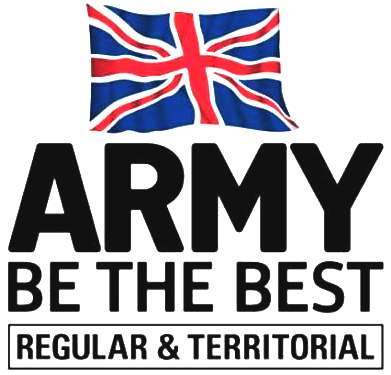|
The British Army is the land warfare branch of British Armed Forces in the United Kingdom. It came into being with the unification of the Kingdom of England and Scotland into the Kingdom of Great Britain in 1707. The new British Army incorporated Regiments that had already existed in England and Scotland and was administered by the War Office from
London. It has been managed by the Ministry of Defence since 1964.
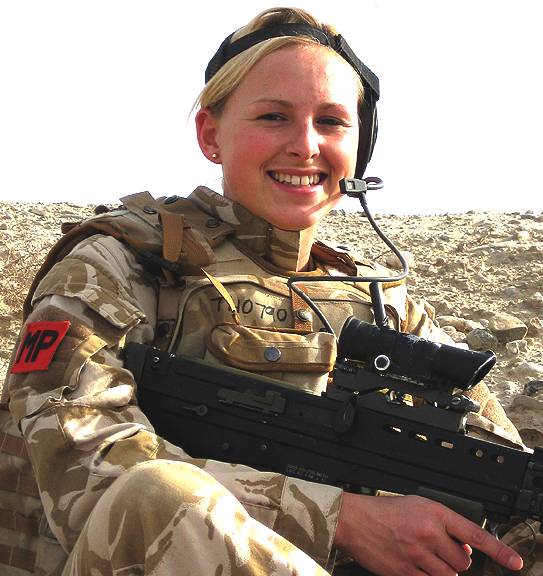
Female member of the Royal Military Police, British Army
The full-time element of the British Army is referred to as the Regular Army since the creation of the reservist Territorial Force in 1908. The British Army is deployed in many of the world's war zones as part of both Expeditionary Forces and in United Nations Peacekeeping forces. The British Army is currently deployed in Kosovo, Cyprus,
Germany, Afghanistan and many other places.
All members of the Army swear (or affirm) allegiance to the monarch as commander-in-chief. However the Bill of Rights of 1689 requires Parliamentary consent for the
Crown to maintain a standing army in peacetime. Parliament therefore annually approves the continued existence of the Army.
In contrast to the Royal
Navy, Royal Marines and Royal Air
Force, the British Army does not include Royal in its title. Many of the Army's constituent Regiments and Corps have been granted the "Royal" prefix and have members of the Royal Family occupying senior positions within some regiments.
The professional head of the British Army is the Chief of the General Staff, currently General Sir Peter Wall KCB CBE ADC Gen.
History of the British Army
The Duke of Marlborough was one of the first generals in the
British Army, fighting campaigns in the War of the Spanish Succession.The British Army came into being with the merger of the Scottish Army and the English Army, following the unification of the Kingdom of England and the Kingdom of Scotland, as the Kingdom of Great Britain in 1707. The new British Army incorporated existing English and Scottish regiments, and was controlled from
London.
From the time of the end of the Seven Years' War in 1763, Great Britain and its successor the United Kingdom has been one of the leading military and economic powers of the
world.
Early British
Empire
The British Empire expanded in this time to include colonies, protectorates, and Dominions throughout the Americas,
Africa, Asia and Australasia. Although the Royal Navy is widely regarded as having been vital for the rise of the British Empire, and British dominance of the world, the British Army played an important role in the colonisation of India and other
regions. Typical tasks included garrisoning the colonies, capturing strategically important territories, and participating in actions to pacify colonial borders, provide support to allied governments, suppress Britain's rivals, and protect against foreign powers and hostile natives.
The death of General Wolfe during the Battle of the Plains of Abraham; the campaigns of the French and Indian War resulted in British control of modern
Canada. British troops also helped capture strategically important territories, allowing their empire to expand throughout the globe. The army also involved itself in numerous wars meant to pacify the borders, or to prop-up friendly governments, and thereby keep other, competitive, empires away from the British Empire's borders. Among these actions were the Seven Years'
War, the American Revolutionary War, the Napoleonic
Wars, the First and Second Opium Wars, the Boxer
Rebellion, the New Zealand land
wars, the Sepoy Rebellion of 1857, the First and Second Boer
Wars, the Fenian raids, the Irish War of Independence, its serial interventions into Afghanistan (which were meant to maintain a friendly buffer state between British India and the Russian
Empire), and the Crimean War (to keep the Russian Empire at a safe distance by coming to Turkey's
aid).
As had its predecessor, the English Army, the British Army fought Spain,
France, and the Netherlands for supremacy in
North America and the West Indies. With native and provincial assistance, the Army conquered New France in the Seven Years'
War and subsequently suppressed a Native American uprising in Pontiac's
War. The British Army suffered defeat in the American War of Independence, losing the Thirteen Colonies but holding on to
Canada.
The Duke of Wellington's and Field Marshal von Blücher's triumph over Napoleon Bonaparte at the Battle of WaterlooThe British Army was heavily involved in the Napoleonic Wars in which the army served in multiple campaigns across Europe (including continuous deployment in the Peninsular War), the Caribbean, North Africa and later in North America. The war between the British and the First French Empire of Napoleon Bonaparte stretched around the world and at its peak, in 1813, the regular army contained over 250,000 men. A Coalition of Anglo-Dutch and Prussian Armies under the Duke of Wellington and Marshal Bulcher defeated Napoleon at the Battle of Waterloo in
1815.
The English had been involved, both politically and militarily, in Ireland since being given the Lordship of Ireland by the pope in 1171. English republican dictator, Oliver Cromwell's campaign was characterised by its uncompromising treatment of the Irish towns (most notably Drogheda) that had supported the Royalists during the English Civil War. The English Army (and subsequently the British Army) stayed in Ireland primarily to suppress numerous Irish revolts and campaigns for independence. It was faced with the prospect of battling Anglo-Irish and Ulster Scots peoples in Ireland, who alongside their other Irish groups had raised their own volunteer army and threatened to emulate the American colonists if their conditions were not met. The British Army found itself fighting Irish rebels, both Protestant and Catholic, primarily in Ulster and Leinster (Wolfe Tone's United Irishmen) in the 1798
rebellion.
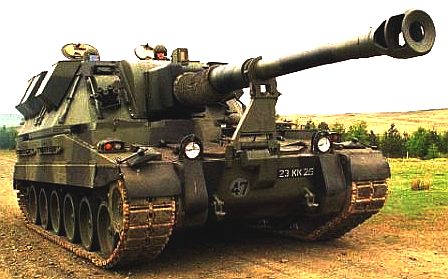
British Army 155mm Braveheart howitzer
The Battle of Rorke's Drift in 1879 saw a small British force repel an overwhelming attack by Zulu forces; eleven Victoria Crosses were awarded for the defence.In addition to battling the armies of other European Empires (and of its former colonies, the United States, in the American War of
1812), in the battle for global supremacy, the British Army fought the Chinese in the First and Second Opium
Wars, and the Boxer Rebellion, Māori tribes in the first of the New Zealand
Wars, Nawab Shiraj-ud-Daula's forces and British East India Company mutineers in the Sepoy Rebellion of
1857, the Boers in the First and Second Boer Wars, Irish Fenians in Canada during the Fenian
raids and Irish separatists in the Anglo-Irish War.
Following William and Mary's accession to the throne, England involved itself in the War of the Grand Alliance primarily to prevent a French invasion restoring Mary's father, James
II. Following the 1707 union of England and Scotland, and the 1801 creation of the United Kingdom of Great Britain and Ireland, British foreign policy, on the continent, was to contain expansion by its competitor powers such as France and Spain. The territorial ambitions of the French led to the War of the Spanish
Succession and the Napoleonic Wars. Russian activity led to the Crimean
War. After 1745 recruits were increasingly drawn from Scotland; by the mid-1760s between one fifth and one third of officers were from
Scotland.
The vastly increasing demands of imperial expansion, and the inadequacies and inefficiencies of the underfunded, post-Napoleonic Wars British Army, and of the Militia, Yeomanry, and Volunteer Force, led to the Cardwell and Childers Reforms of the late 19th century, which gave the British Army its modern shape, and redefined its regimental
system. The British army also lagged behind other nations in some aspects of their military. On Queen Victoria's death, they did not have a general staff, a permanent divisional and corps organization, or enlistment by conscription. The Haldane Reforms of 1907, formally created the Territorial Force as the Army's volunteer reserve
component.
Challenger
tank firing
World
Wars
The Second Battle of El Alamein reversed German ambitions in North Africa, and is often cited as one of the turning points of the Second World War.
Britain's dominance of the world had been challenged by numerous other powers, notably Germany. The UK was allied with France (by the Entente Cordiale) and Russia, and when the First World War broke out in 1914, the British Army sent the British Expeditionary Force to France and Belgium to prevent Germany from occupying these
countries. The British Army created the Mediterranean Expeditionary Force in Egypt and sent it to Gallipoli in an unsuccessful attempt to capture Constantinople and secure a sea route to
Russia. After the retreat from Gallipoli nearly 400,000
men in 13 divisions from the Mediterranean Expeditionary
Force and the Force in Egypt formed a strategic reserve in Egypt called the Egyptian Expeditionary
Force.
With most of the strategic reserve sent to the Western Front, an Egyptian Expeditionary Force of two British infantry and one Australian and New Zealand mounted division in Eastern Force, successfully defend the Suez Canal and Romani in 1916 from German and Ottoman
incursions. This force captured the Sinai and garrisoned the extended lines of communication, but in early 1917 their advance was stopped at Gaza until towards the end of the year when a greatly enlarged force of infantry and mounted troops captured Beersheba, most of southern Palestine and Jerusalem. Allenby's force, now including Indian Army units which replaced a number of British units sent to the Western Front, captured the southern Jordan Valley in 1918 and carried out two major, but unsuccessful attacks to Amman and Es Salt and occupied part of the Jordan Valley, during preparations for his final successful assault in September at the Battle of Megiddo. As a result of the Egyptian Expeditionary Force's capture of two Ottoman armies, an armistice with the Ottoman Empire was signed on 31 October
1918.
The War would be the most devastating in British military history, with near 800,000 men killed and over 2 million wounded. In the early part of the war, the professional force of the BEF was virtually destroyed and, by turns, a volunteer (and then conscripted) force replaced it. Major battles included the Battle of the
Somme. Advances in technology saw advent of the tank, with the creation of the Royal Tank Regiment, and advances in aircraft design, with the creation of the Royal Flying Corps, which were to be decisive in future
battles. Trench warfare dominated strategy on the Western Front, and the use of chemical and poison gases added to the
devastation.
The Second World War broke out in 1939 with the German invasion of
Poland. British assurances to the Polish led the British Empire to declare war on Germany. Again an Expeditionary Force was sent to
France, only to be hastily evacuated as the German forces swept through the Low Countries and across France in
1940. Only the Dunkirk evacuation saved the entire Expeditionary Force from
capture. Later, however, the British would have spectacular success defeating the Italians and Germans at the Battle of El Alamein in North
Africa, and in the D-Day invasion of Normandy with the help of American, Canadian, Australian and New Zealand
forces. Almost half of the Allied soldiers on D-day were
British. In the Far East, the British army battled the
Japanese in Burma. The Second World War saw the British army develop its Special Air Service, Commando units and the Parachute
Regiment.
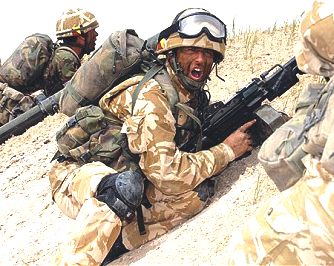
British army infantry wearing desert camouflage
Postcolonial era
Soldiers from the Parachute Regiment guard Argentine prisoners of war during the Falklands War.After the end of the Second World War, the British Army was significantly reduced in size, although National Service continued until
1960. This period also saw the process of Decolonisation commence with the end of the British Raj, and the independence of other colonies in Africa and Asia. Accordingly the army's strength was further reduced, in recognition of Britain's reduced role in world affairs, outlined in the 1957 Defence White
Paper. This was despite major actions in Korea in 1950 and Suez in
1956. A large force of British troops also remained in Germany, facing the threat of Soviet
invasion. The British Army of the Rhine was the Germany garrison formation, with the main fighting force being I (BR) Corps. The Cold War saw significant technological advances in warfare and the Army saw more technologically advanced weapons systems come into
service.
Despite the decline of the British Empire, the Army was still deployed around the world, fighting wars in
Aden, Indonesia, Cyprus, Kenya and Malaya. In 1982 the British Army, alongside the Royal Marines, helped to recapture the Falkland Islands during the Falklands conflict against
Argentina.
In the three decades following 1969, the Army was heavily deployed in Northern Ireland, to support the Royal Ulster Constabulary (later the Police Service of Northern Ireland) in their conflict with republican paramilitary groups, called Operation
Banner. The locally recruited Ulster Defence Regiment was formed, later becoming the Royal Irish Regiment in 1992. Over 700 soldiers were killed during the Troubles. Following the IRA ceasefires between 1994 and 1996 and since 1997, demilitarisation has taken place as part of the peace process, reducing the military presence from 30,000 to 5,000 troops.[52] On 25 June 2007, the Second Battalion Princess of Wales's Royal Regiment vacated the Army complex at Bessbrook Mill in Armagh. This is part of the 'normalisation' programme in Northern Ireland in response to the IRA's declared end to its
activities.
Challenger
diesel turbo at Bovington
Personnel
The British Army is purely a professional force since National service came to an end. The full-time element of the British Army is referred to as the Regular Army since the creation of the reservist Territorial Force in 1908. As of 1 November 2011, the British Army employs 109,520 Regulars[54] (which includes the 3,780 Brigade of Gurkhas) and 33,100 Territorials for a combined component strength of 142,620 soldiers. In addition there are 121,800 Regular Reserves of the British
Army.
The strength of the British Army is continually evolving. A publication released on 18 July 2011 entitled "Future Reserves 2020 - The Independent Commission to review the United Kingdom's Reserve Forces" envisioned that by 2015 the Territorial Army will be increased to a trained strength of around 30,000 personnel (38,000 including those in
training). Furthermore the Commissions view is that post 2015 the trained strength of the Territorial Army will continue to increase allowing for a British Army (Regular and Territorial) with a trained strength of 120,000 personnel by 2020. This reform will bring the ratio of regular and part-time personnel of the British Army in-line with US and
Canadian
allies.
As per the October 2010 Strategic Defence and Security Review the regular British Army will be reduced to a trained strength of 95,500 personnel by 2015 (around 105,000 including those in
training). However, post 2015, and in conjunction with the Commissions planning as set out in "Future Reserve 2020" the regular army will be reduced to around 84,000 trained personnel by
2020.
Equipment
The basic infantry weapon of the British Army is the L85A2 assault rifle, sometimes equipped with an L17A2 underbarrel grenade launcher and with several variants such as the L86A2, the Light Support Weapon (LSW) and the L22A2 carbine variant, issued to tank crews. Support fire is provided by the FN Minimi light machine gun and the L7 General Purpose Machine Gun (GPMG); indirect fire by 51 and 81 mm mortars. Sniper rifles used include the L118A1 7.62 mm, the L115A3 and the AW50F, all produced by Accuracy International. Some units use the L82A1 .50 calibre Barrett sniper rifle. More recently the L128A1 (Benelli M4) 'combat shotgun' has been adopted, and is intended for close quarters combat in
Afghanistan.
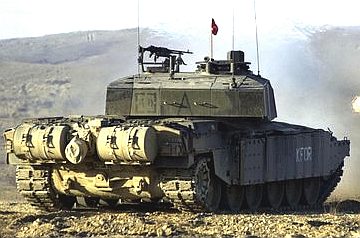
Challenger II main battle
tank rear
Armour
The British Army's main battle tank is Challenger
2. Other armoured vehicles include Supacat "Jackal" MWMIK and the Iveco "Panther" CLV.[64] The Warrior Infantry Fighting Vehicle is the primary armoured personnel carrier, although many variants of the Combat Vehicle Reconnaissance (tracked) are used, as well as the Saxon APC and FV430 series now being re-engined and uparmoured and returned to front line service as
Bulldog. The British Army commonly uses the Land Rover Wolf and Land Rover
Defender.
Artillery The Army uses three main artillery systems: the Multi Launch Rocket System (MLRS), AS-90 and L118. The MLRS was first used operationally in Operation Granby and has a range of 70 km (43
mi). The AS-90 is a 155 mm self-propelled gun. The L118 Light Gun is a 105 mm towed gun used primarily in support of 16 Air Assault Brigade, 19 Light Brigade and 3 Commando Brigade (Royal
Marines). The Rapier FSC Missile System is the Army's primary battlefield air defence system, widely deployed since the Falklands
War and the Starstreak HVM (High Velocity Missile) is a surface-to-air weapon, launched either by a single soldier or from a vehicle-mounted
launcher.
Army Aviation
The Army Air Corps (AAC) provide direct aviation support for the Army, although the RAF also assist in this role. The primary attack
helicopter is the Westland WAH-64 Apache, a license-built, modified version of the AH-64 Apache that will replace the Westland Lynx AH7 in the anti-tank
role. The Bell 212 is used as a specialist utility and transport helicopter, with a crew of two and a transport capacity of 12
troops. The Westland Gazelle helicopter is a light helicopter, primarily used for battlefield reconnaissance and control of artillery and
aircraft. The Eurocopter AS 365N Dauphin is used for Special Operations
Aviation and the Britten-Norman Islander is a light aircraft used for airborne reconnaissance and
command.
Recent and current conflicts
Gulf War and Operation Granby
The ending of the Cold War saw a significant cut in manpower, as outlined in the Options for Change
review. Despite this, the Army has been deployed in an increasingly global role, and contributed 50,000 troops to the coalition force that fought Iraq in the Gulf
War. British forces were put in control of Kuwait after it was liberated. 47 British Military personnel died during the Gulf
War.
Balkans
conflicts
Yugoslav wars
The British Army was deployed to Yugoslavia in 1992; initially this force formed part of the United Nations Protection
Force. In 1995 command was transferred to IFOR and then to SFOR. Currently troops are under the command of EUFOR. Over 10,000 troops were sent. In 1999 British forces under the command of SFOR were sent to Kosovo during the conflict there. Command was subsequently transferred to KFOR. Between early 1993 and June 2010, 72 British military personnel died on operations in the former Yugoslavian countries of Bosnia, Kosovo and
Macedonia.
Afghanistan (2001–present) and Operation Herrick
British soldiers in Afghanistan.In 2001 the United Kingdom, as a part of Operation Enduring Freedom with the United States, invaded Afghanistan to topple the
Taliban. The 3rd Division were deployed in Kabul, to assist in the liberation of the troubled capital. The Royal Marines' 3 Commando Brigade (part of the Royal Navy but including a number of Army units), also swept the
mountains. The British Army is today concentrating on fighting Taliban forces and bringing security to Helmand province.
Approximately 9,000 British troops (including marines, airmen and sailors) are currently in Afghanistan, making it the second largest force after the US. Around 500 extra British troops were deployed in 2009, bringing the British Army deployment total up to 9,500 (excluding Special
Forces). Between 2001 and May 2012 a total of 414 British military personnel have died on operations in
Afghanistan.
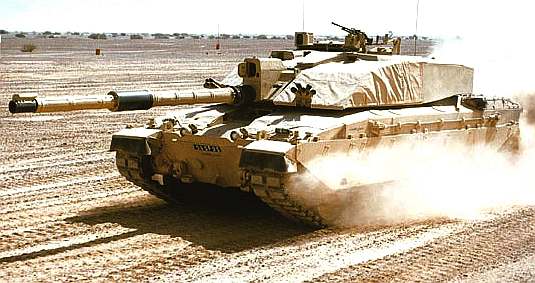
Challenger II main battle
tank at speed
Iraq War and Operation Telic
In 2003, the United Kingdom was a major contributor to the United States-led invasion of Iraq. There was major disagreement amongst the domestic populace but the House of Commons voted for the conflict, sending a force that would reach 46,000 military
personnel. The British Army controlled the southern regions of Iraq and maintained a peace-keeping presence in the city of Basra until their withdrawal on April 30, 2009. 179 British Military personnel have died on operations in
Iraq. All of the remaining British troops were fully withdrawn from Iraq after the Iraqi government refused to extend their
mandate.
Northern Ireland
Operation Banner
Although having permanent garrisons there, the British Army was initially deployed in a peacekeeping role – codenamed "Operation Banner" – in Northern Ireland in the wake of Unionist attacks on Nationalist communities in
Derry and Belfast and to prevent further Loyalist attacks on Catholic communities, under Operation Banner between 1969 and 2007 in support of the Royal Ulster Constabulary (RUC) and its successor, the Police Service of Northern Ireland (PSNI).[93] There has been a steady reduction in the number of troops deployed in Northern Ireland since the Good Friday Agreement was signed in
1998. In 2005, after the Provisional Irish Republican Army announced an end to its armed conflict in Northern Ireland, the British Army dismantled posts and withdrew many troops, and restored troop levels to that of a peace-time
garrison.
Operation Banner ended at midnight on 31 July 2007, bringing to an end some 38 years of continuous deployment, making it the longest in the British Army's
history. An internal British Army document released in 2007 stated that the British Army had failed to defeat the IRA but had made it impossible for them to win through the use of violence. Operation Helvetic replaced Operation Banner in 2007 maintaining fewer servicemen in a much more benign
environment. From 1971 to 1997 a total of 763 British military personnel were killed during the
"Troubles". Some 300 deaths during the conflict were attributed to the British Army, including paramilitary and
civilians. A total of 303 RUC officers were killed
Formation and
structure
Combat Arms
Royal Armoured Corps
Infantry
Guards Division
Scottish Division
King's Division
Queen's Division
Prince of Wales' Division
Royal Irish Regiment
Parachute Regiment
Royal Gurkha Rifles
The Rifles
Special Air Service
Army Air Corps
Combat Support Arms
Royal Artillery
Royal Engineers
Royal Corps of Signals
Intelligence Corps
Combat Services
Royal Army Chaplains Department
Royal Logistic Corps
Army Medical Services
Royal Army Medical Corps
Royal Army Dental Corps
Royal Army Veterinary Corps
Queen Alexandra's Royal Army Nursing Corps
Royal Electrical and Mechanical Engineers
Adjutant General's Corps
Educational and Training Services Branch
Army Legal Services Branch
Royal Military Police
Military Provost Staff Corps
Small Arms School Corps
Royal Army Physical Training Corps
General Service Corps
Corps of Army Music
Structure of the British Army
The structure of the British Army is complex, due to the different origins of its various constituent parts. It is broadly split into the Regular Army (full-time Officers/soldiers and units) and the Territorial Army (Spare-time Officers/soldiers and units).
In terms of its military structure, it has two parallel organisations, one administrative and one operational.
Infantry
soldier
Administrative
Regiments and Corps. These are listed below (in the template to the right), ranging from the Household Cavalry to the Army Physical Training Corps and the Royal Logistic Corps. Uniquely and somewhat confusingly, the Infantry, which is not a corps but a collection of separate regiments, is administered by 'Divisions' of infantry – Guards Division, Queen's Division, Scottish Division and so
on.
Operational
The major operational command is based at Andover and is known as "Army
Headquarters". It is split into divisions and subordinate units ranging from regiments to squadrons.
Divisions (1 Div. based in Herford in Germany and 3 Div. based in Bulford)
Brigades, both fighting and in a non fighting regional capacity within HQ LF (for example,, 43 (Wessex) Brigade based in
Bulford).
Structure of units
The standard operational units are structured as follows, although various units have their own structure, conventions, names and
sizes:
Type of Unit Division
Brigade Battalion / Regiment Company / Squadron Platoon / Troop Section Fire Team
Corps are made up of two or more divisions, but now are rarely deployed as a purely national formation due to the size of the British
Army.
In place of a Battalion, a task-specific Battlegroup may be formed. A battlegroup is grown around the core of either an armoured regiment or infantry battalion, and has other units added or removed from it as necessary for its purpose. It results in a mixed formation of armour, infantry, artillery, engineers and support units, typically consisting of between 600 and 700 soldiers under the command of a Lieutenant
Colonel.
A number of elements of the British Army use alternative terms for battalion, company and platoon. These include the Royal Armoured Corps, Corps of Royal Engineers, Royal Logistic Corps, and the Royal Corps of Signals who use regiment (battalion), squadron (company) and troop (platoon). The Royal Artillery are unique in using the term regiment in place of both corps and battalion, they also replace company with battery and platoon with
troop.
Divisions
The British Army currently has two operational
divisions:
1st Armoured Division Herford, Germany Two armoured brigades.
3rd Infantry Division Bulford, Salisbury Two mechanized brigades, one light brigade and one infantry brigade.
There are also a some ten brigades which are not part of any division report directly into Support
Command.
Aviation
components
The British Army operates alongside the Royal Air Force as part of a Joint Force, but the army also has its own Army Air Corps. Military helicopters of all three services are commanded by Joint Helicopter Command, a joint 2 star headquarters operating under HQ Land
Forces.
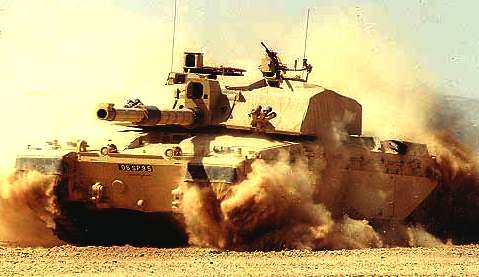
Challenger
British Army main battle tank turning at speed
Special forces
The SAS Cap Badge.
The British Army contributes two of the three special forces formations within the United Kingdom Special Forces Command; the Special Air Service Regiment and the Special Reconnaissance
Regiment. The most famous formation is the Special Air Service Regiment. The SAS comprises one regular Regiment and two Territorial Army
Regiments.
The regular Regiment, 22 SAS, has its headquarters and depot located in Hereford and consists of five squadrons: A, B, D, G and Reserve with a training
wing. The two reserve SAS Regiments; 21 SAS and 23 SAS have a more limited role, to provide depth to the UKSF group through the provision of Individual and collective augmentation to the regular component of UKSF and standalone elements up to task group (Regimental) level focused on support and influence (S&I) operations to assist conflict
stabilisation.
The Special Reconnaissance Regiment (SRR), formed in 2005 from existing assets, undertakes close reconnaissance and special surveillance
tasks. Formed around 1st Battalion the Parachute Regiment, with attached Royal Marines assets, the Special Forces Support Group are under the Operational Control of Director Special Forces to provide operational manoeuvre support to the elements of United Kingdom Special
Forces.
Overseas Territories military
units
Numerous military units were raised historically in British territories, including self-governing and Crown colonies, and protectorates. Whereas the Dominions, such as
Canada and Australia, have their own armies, the defence of certain overseas territories is still supported by the British Army:
1. Bermuda Regiment
2. Gibraltar Regiment
Royal Navy and RAF ground
units
The other armed services have their own infantry units which are not part of the British Army. The Royal Marines are amphibious light infantry forming part of the Naval Service, and the Royal Air Force has the RAF Regiment used for airfield defence, force protection duties and Forward Air
Control.
Recruitment
The Army mainly recruits within the United Kingdom; it normally has a recruitment target of around 12,000 soldiers per
year.
Low unemployment in Britain has resulted in the Army having difficulty in meeting its target. In the early years of the 21st century there has been a marked increase in the number of recruits from other (mostly Commonwealth) countries. In 2006 overseas recruitment, mostly in Commonwealth countries, generated more than 6,000 soldiers from 54 nations; together with the 3,000 Gurkhas, 10% of the British Army is a foreign
national.
The Ministry of Defence now caps the number of recruits from Commonwealth countries, although this will not affect the Gurkhas. If the trend continues 10% of the army will be from Commonwealth countries before 2012. The cap is in place as some fear the army's British character is being diluted, and employing too many could make the army seen as employing
mercenaries.
The minimum recruitment age is 16 years (after the end of GCSEs), although soldiers may not serve on operations below 18 years; the maximum recruitment age was raised in January 2007 from 26 to 33 years. The normal term of engagement is 22 years, and, once enlisted, soldiers are not normally permitted to leave until they have served at least 4
years.
There has been a strong and continuing tradition of recruiting from Ireland including what is now the Republic of
Ireland. Over 200,000 Irish soldiers fought in the First World War. More than 60,000 Irishmen from what was then the Irish Free
State (now the Republic of Ireland) and 38,000 from Northern Ireland served in the Second World
War, all volunteered.
Oath of allegiance
Troops of the Grenadier Guards on guard at Buckingham Palace. Various army regiments supply troops to guard the Royal residences.All soldiers must take an oath of allegiance upon joining the Army, a process known as attestation. Those who believe in God, and wish to swear by Him, use the following words:
"I (your name), swear by Almighty God that I will be faithful and bear true allegiance to Her Majesty Queen Elizabeth II, her heirs and successors and that I will as in duty bound honestly and faithfully defend Her Majesty, her heirs and successors in person, crown and dignity against all enemies and will observe and obey all orders of Her Majesty, her heirs and successors and of the generals and officers set over
me."
Others replace the words "swear by Almighty God" with "solemnly, sincerely and truly declare and
affirm".
Training establishments
The Royal Military Academy Sandhurst is the home of British Army officer
training. Royal Military Academy Sandhurst (RMAS) is the officer training establishment. All officers, regular and reserve, attend RMAS at some point in their training.
Royal School of Artillery (RSA) trains the Royal Artillery.
Royal School of Military Engineering (RSME) trains the Corps of Royal Engineers as well as personnel from across the Armed Forces and other Government Departments in a variety of general engineering and specialist skills.
Army Training Regiments:
ATR Bassingbourn
ATR Winchester
ATC Pirbright
Infantry Training Centres:
ITC Catterick
Infantry Battle School, Brecon
Support Weapons School, Warminster
Army Foundation College (Harrogate)
Regional training centres
Welbeck Defence Sixth Form College
Light
armoured tactical vehicle
Serving
Soldier | Soldier
Welfare & Family | Careers
| News
| Units
| Deployments
Museums
| Equipment
| Sport
| What's
New
HQ LAND COMMAND
HQ Land Command
is located at Erskine Barracks, Wilton near Salisbury and
controls about 75% of the troops in the British Isles and almost
100% of its fighting capability.
Land Command's
role is to deliver and sustain the Army's operational
capability, wherever required through out the world, and the
Command comprises all operational troops in Great Britain,
Germany, Nepal and Brunei, together with the Army's Training
Teams in Canada, Belize and Kenya. Land Command has almost
70,000 trained Army personnel - the largest single Top Level
Budget in Defence, with a budget of just under £3 billion. It
contains all the Army's fighting equipment, including attack
helicopters, Challenger 2 tanks, Warrior Infantry Fighting
Vehicles, AS90 (the new artillery gun) and the Multi-Launched
Rocket System (MLRS).
Land Command is
one of the three major commands in the British Army, the other
two being the Adjutant General (with responsibility for
administration, personnel and training) and the Quartermaster
General (responsible for supply and logistics). The Command is
responsible for providing all the Army's fighting troops
throughout the World. These are organised into eight formations
and are commanded by Major Generals.
The Army is
currently deployed in over 80 countries around the world.
Deployments vary in strength from single military advisors to
full operational deployments. Click on the map below to find out
more about our many worldwide commitments, major training
facilities and centres of population.
Listed below the map are other geographical areas associated
with the British Army which may be of interest to you.

FANCY THE
TERRITORIAL ARMY
The TA is an essential element of the
British Armed Forces. It forms one quarter of the British
Army, playing the vital dual role of reinforcing the Regular
Army and serving local communities in times of need. And
it is the chance for thousands of civilians to satisfy their
need for a challenging new experience.
The Territorial Army is that part of
the British Army staffed on a paid voluntary basis by part-time
personnel - everyday people with the drive to devote some of
their spare time to an extremely important organisation.
In joining the TA you will have access
to an exciting range of opportunities:
-
To develop your existing skills
while learning new ones
-
To push yourself to achieve things
you never thought possible
-
To play a fundamental role in
fulfilling the Army's commitment to defensive, humanitarian
and peacekeeping operations in the UK and worldwide.
Please take the time to explore their
website and order
their CD ROM to find out more about what the TA is and how
you can form an important part of what it stands for.
TA
SOLDIER | TA
OFFICER | TA
MEDICAL | TA
SPECIALIST
LINKS:
A
taste for adventure capitalists

Solar
Cola - a healthier alternative
|
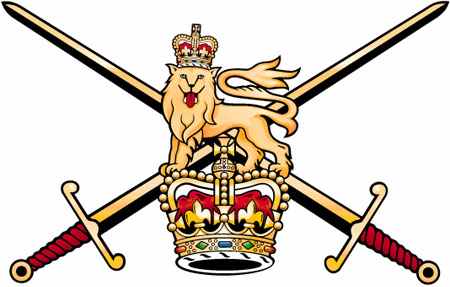 THE BRITISH ARMY
THE BRITISH ARMY 